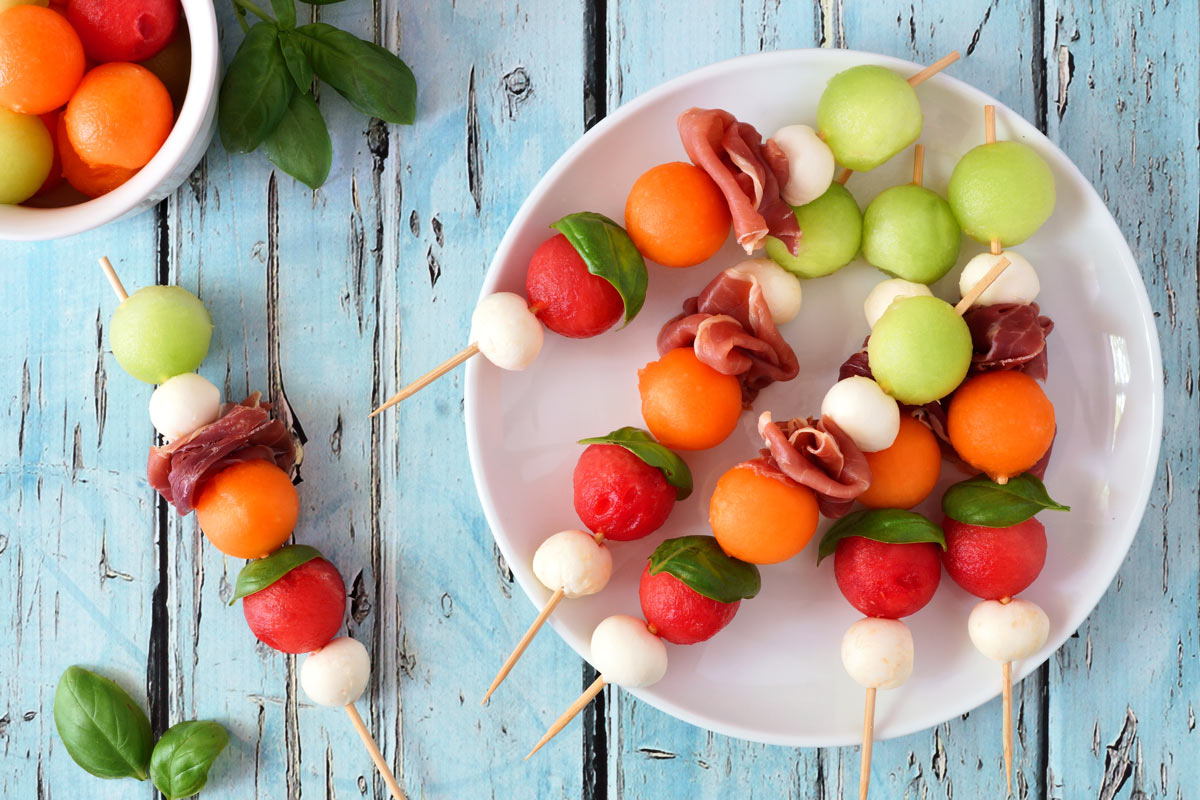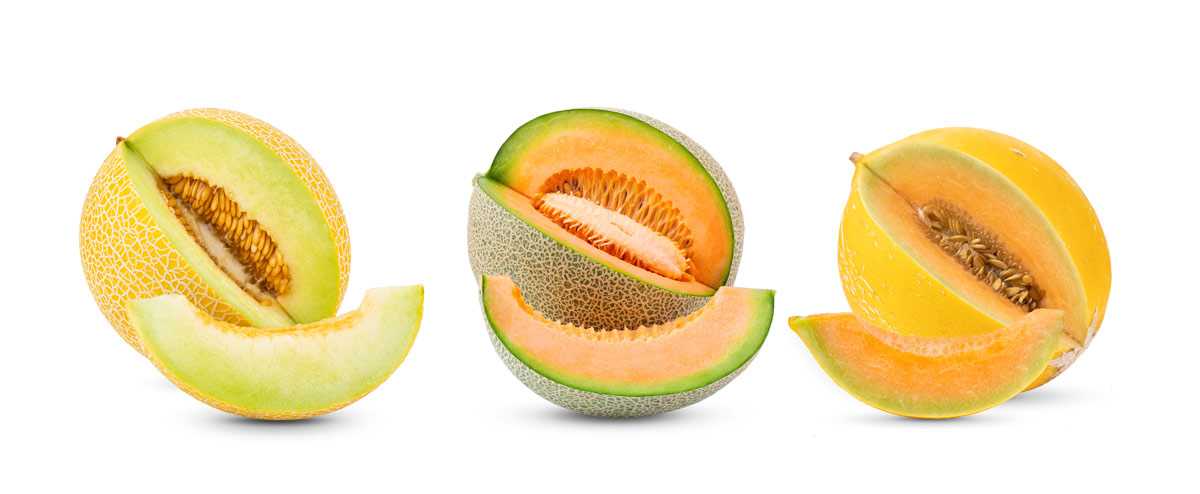Summer on a Skewer Recipe, Spotlight on Muskmelons, Magnesium for Bone Health, Plus Walking to Alleviate Back Pain
Summer brings an amazing bounty of produce along with often-sweltering temps that make a hot kitchen the last place you want to be. I love these fruit-and-cheese skewers because there’s virtually no prep involved, yet the finished dish is elegant enough for a patio party! Are you a fan of nuts and seeds? These are excellent sources of an often-overlooked mineral that plays a vital role in bone health: magnesium. Read more about it below along with the results of a study on a simple way to help ease back pain.
Summer on a Skewer
 Summer on a Skewer
Summer on a SkewerWant an elegant lunch, first course, or light supper that doesn’t require any complex prep or cooking? Here are twists on two summer salad favorites: feta with watermelon and cantaloupe with prosciutto. When served on skewers, they become the perfect finger food. Make one variety or both, or mix and match the ingredients for a colorful presentation. The sweetness of the melons and the slight saltiness of the cheeses are elevated by a drizzle of olive oil and a splash of balsamic—no need to whisk up a vinaigrette.
Ingredients
For the feta skewers:
- 8-ounce block feta, preferably from Greece
- 1/2 ripe watermelon
- Mint leaves
- 6 long bamboo skewers
For the mozzarella skewers:
- 1 large cantaloupe or honeydew
- 12 mini mozzarella balls
- 6 slices of prosciutto, halved and rolled up, or 12 thin slices of your favorite salami
- Basil leaves
- 6 long bamboo skewers
For serving:
- Extra virgin olive oil
- Best-quality balsamic vinegar of Modena such as Condimento Barili Exclusivi
- Freshly ground black pepper
Directions
For the feta skewers, cut the feta and the watermelon into similarly sized cubes, 18 of the watermelon and 12 of the feta. Assemble ingredients on each skewer in this order: watermelon, mint, feta; repeat the pattern and then cap each skewer with an extra piece of watermelon.
For the mozzarella skewers, use a melon baller to make 18 melon balls close in size to the mozzarella. Assemble ingredients on each skewer in this order: melon, basil, prosciutto; repeat the pattern and then cap each skewer with an extra piece of melon.
Arrange the skewers on a platter and drizzle liberally with olive oil, splashes of balsamic, and a few twists from your black peppercorn grinder.
Yields 6 servings

Healthy Ingredient Spotlight
Muskmelons
That’s the umbrella term of all sweet melons other than watermelon. While watermelon is alone in its category, there are close to two dozen muskmelon varieties, some smooth skinned and others with a rough pattern often described as a netting. Most people are familiar with cantaloupe and honeydew, but there are many more to explore, each delicious in its own way.
There’s a refreshing sweetness to casaba, crenshaw, and canary melons, with white, orange-pink, and pale green flesh, respectively. Becoming more available at farmers’ markets and Asian specialty stores are the round Persian melon with sweet pink flesh and the Chinese hami melon, which is extra sweet. Experiment with them in any recipe that calls for cantaloupe or honeydew, or just enjoy a thick slice on its own.
Melons have a high water content as well as important vitamins, minerals, and fiber. Muskmelons are typically rich in vitamin C, with cantaloupe topping the nutrient list: a one-cup serving has 95% of the vitamin C you need a day and all the vitamin A. (The rich red color of watermelon comes from lycopene, an important antioxidant, so enjoy it, too!)

Quick Kitchen Nugget
Choosing Melons

Buying a whole melon can seem like playing a mystery game. Its sweetness is set at the time of harvest, and the rind doesn’t even indicate the color of the flesh. But there are some clues to help you pick a ripe, sweet melon. Whether round or oblong, the melon should be symmetrical in shape. It should feel weighty in your hands. Checking out the stem end is also key. Unlike a prime pumpkin, there shouldn’t be any stem still attached, and the indentation it left should be hollow and smooth.
When a melon with netting on the rind is ripe, you should be able to easily smell its sweet aroma. But you won’t pick up any scent from a smooth-skinned melon like honeydew. Instead, look for a rind that’s more of a creamy shade rather than a stark color like green. A good watermelon should have a large, creamy-yellow spot where it sat on the ground, and the overall rind should be matte or dull, not shiny.
In terms of food safety, always rinse melons well before cutting to get rid of potential bacteria; those with netting will benefit from a light scrub with a vegetable brush. Pat the melon dry before prepping.

For Your Best Health
Magnesium: The missing Mineral for Bone Health

We already know the importance of calcium and vitamin D for strong bones, but we don’t often hear about magnesium, another key mineral. Magnesium is found in legumes, nuts, seeds, whole grains, and green leafy vegetables, so it shouldn’t be a challenge for anyone following a Mediterranean-style diet to get enough of this essential nutrient.
Adults need between 310 and 420 mg of magnesium per day, with no more than 350 mg coming from any kind of supplement. That’s because high amounts of supplemental magnesium can cause side effects like stomach cramps and nausea (excessive amounts have even been linked to an irregular heartbeat and heart attack, according to the NIH). But there’s no limit on how much you can get from food. If you love nuts and seeds, you’ll be especially thrilled that the top sources of magnesium include one-ounce servings of pumpkin seeds (156 mg), chia seeds (111 mg), almonds (80 mg), cashews (74 mg), and peanuts (63 mg). Other good foods are half-cup servings of cooked spinach (78 mg), black beans (60 mg), and edamame (50 mg); 2 tablespoons peanut butter (49 mg); and a 3-1/2 ounce baked potato with skin (43 mg).

Fitness Flash
Walking: Help for that Achin’ Back
About 800 million people worldwide have low back pain, a leading cause of disability and diminished quality of life. Repeated episodes of low back pain are common: 7 in 10 people who recover from one episode of low back pain go on to have another within a year.
The current best practice for back pain management and prevention is a combination of exercise and education. However, some forms of exercise don’t work for many people because of reasons like high cost, complexity, and the need for supervision. A clinical trial by Macquarie University Spinal Pain Research Group in Sydney, Australia, looked at whether walking could fit the bill. Their study, “Effectiveness and cost-effectiveness of an individualised, progressive walking and education intervention for the prevention of low back pain recurrence in Australia (WalkBack): A randomised controlled trial” was published in The Lancet.
The trial involved 701 adults who had recently recovered from an episode of low back pain and who were randomly allocated to either an individualized walking program and six physiotherapist-guided education sessions over six months, or to a control group. Researchers followed them for between one and three years, depending on when they joined the study. They found that adults with a history of low back pain who walked regularly went nearly twice as long without a recurrence.
According to the paper’s senior author, Macquarie professor of physiotherapy Mark Hancock, PhD, the findings could have a profound impact on how low back pain is managed. “The intervention group had fewer occurrences of activity-limiting pain compared to the control group, and a longer average period before they had a recurrence, with a median of 208 days compared to 112 days,” Dr. Hancock said. “Walking is a low-cost, widely accessible, and simple exercise that almost anyone can engage in, regardless of geographic location, age, or socioeconomic status.
“We don’t know exactly why walking is so good for preventing back pain, but it is likely to include the combination of the gentle oscillatory movements, loading and strengthening the spinal structures and muscles, relaxation and stress relief, and release of ‘feel-good’ endorphins.
And of course, we also know that walking comes with many other health benefits, including cardiovascular health, bone density, healthy weight, and improved mental health.”
Added lead author Natasha Pocovi, PhD, “It not only improved people’s quality of life but reduced both their need to seek healthcare support and the amount of time taken off work by approximately half. The exercise-based interventions to prevent back pain that have been explored previously are typically group based and need close clinical supervision and expensive equipment, so they are much less accessible to the majority of patients. Our study has shown that this effective and accessible means of exercise has the potential to be successfully implemented at a much larger scale than other forms of exercise.”
To build on these findings, the team next hopes to explore how they can integrate the preventive approach into the routine care of patients who experience recurrent low back pain.
Get More Recipes In Your Inbox!